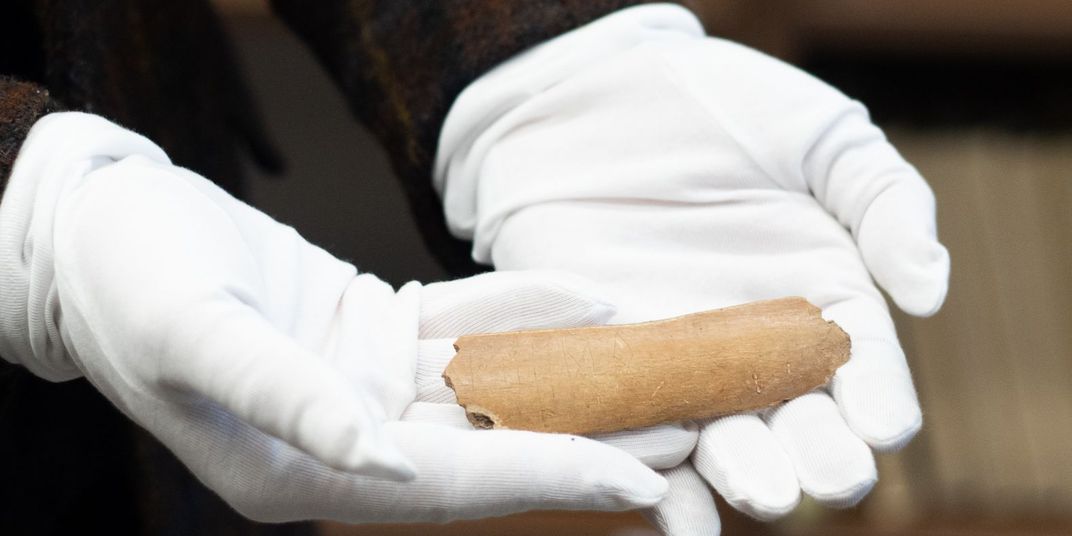BRNO, Czech Republic – Alena Slámová, a graduate student in the Department of Archaeology and Museology at Masaryk University in Brno, noticed during a routine cleaning some unusual markings on a cow bone that had been excavated in 2017. Her keen eye and subsequent decision to show it to colleagues may re-write Slavic history. After three years of cautious research, findings on the bone artifact were published in the Journal of Archaeological Science.
The marking turned out to be runes. The runes are in the Futhark (fuþark) script, familiar to modern Pagans and Heathens as the alphabet used among Germanic tribes and their descendants. Most of the rune-inscribed artifacts that had been previously found in the region were in the Younger Futhark, the version of the alphabet used during the Viking Age. The six-letter inscription on the cow bone, however, used the Elder Futhark, a much older script.
“To date, no archaeological find is generally accepted as evidence for direct contact between Germanic tribes and Early Slavs in Central Europe,” the authors note in the article. “Here we report a novel archaeological find n support of a direct contact: a rune-inscribed fragment of a bone from the late 6th century found in a Slavic settlement.”

Bone Fragment inscribed with Runes (Courtesy: Masaryk University)
The earliest written reports of the Slavic Peoples date to late antiquity and the Middle Ages, when reports from the Byzantine Empire, around the 6th century, described attacks by the Sclavini or Antes for the region that is now northeast Austria, the Czech Republic, and Slovakia. Subsequent Christian missionaries have attestations of the Slavs in the foundational documents of monasteries dated to the 9th century. But there are disputes about human migrations as well as cultural and political influences that clearly distinguish Slavic territories.
Genetic and linguistic studies have helped isolate the regions that were Slavic, and have also helped identify human migration patterns.
The cow bone was discovered in the South Moravia region of the Czech Republic near Břeclav-Lány area, about 25 miles northeast from Vienna, Austria.
“While runology has generally focused on the interpretation of runic inscriptions in terms of runic characters, linguistic forms and text function,” the authors state, “we show here that material science and the scientific analysis of both the inscriptions and the inscribed objects may provide additional, valuable information.”
Indeed, subsequent electron microscopy and radio-carbon dating revealed that the Břeclav-Lány cow bone dates to about the year 600, 300 years prior to the monastic colonization. Genetic analysis confirmed the bone was from cattle.
Prior to the discovery, researchers generally believed that Slavs had not adopted a writing system until the 9th century, when they started using Glagolitic script, which was introduced by Christian missionaries.

Runes clearly visible on the bone fragment (Courtesy: Masaryk University)
Nevertheless, Slavic scholars have long contested the idea that missionaries were uniquely responsible for Slavic literacy. They pointed to commentary by Chernorizets Hrabar, a Bulgarian monk and scholar writing in the 10th century, who noted that Slavs made use of a writing system that was comprised of strokes and incisions.
Jiri Machacek, head of the Department of Archaeology and Museology at Masaryk University in Brno, is the lead author of the research paper. “It was absolutely surprising for us,” he said. They never expected to see an early Slav settlement in the region. “Our find is the first one after nearly 200 years of discussions to suggest that it is possible that the [early Slavs] had some script.”
The author of the inscription is unknown, but it is clear that the individual was familiar with the Futhark script. The authors noted that “from a runologic perspective, the discovered inscription is readily attributed to the South Germanic corpus, albeit likely carved by an inexperienced artist.” The authors suggest that the runes could have been “engraved by a Slav. If runic knowledge was transferred from Germanic peoples to Slavs, it must have happened in Central Europe as judged by the rune shapes.”
The bone does not, however, put to rest the question of Slavic migration or use of alphabets. The find does not rule out some important competing hypotheses.
Florin Curta, a historian and archaeologist at the University of Florida, told the New York Times that the marks are certainly Germanic runes. Speaking as an expert who was independent of the project, Curta called the find as a “very important discovery.” Curta notes that it could have been a local person who spoke and wrote in an early Germanic language.
The find documents that many assumptions of early Germanic and Slavic contact should be re-examined. “The inscribed bone we excavated in 2017 was studied by an international team of researchers from the Czech Republic, Austria, Switzerland, and Australia that found it to be the oldest inscription ever discovered among Slavs,” Macháček said in an interview with Masaryk University News. “This is a major discovery of not just national significance but of European importance.
“The fact that it is the earliest evidence of writing among Slavs is certainly interesting for the nearly 300 million people who speak Slavic languages,” added Macháček.
The Wild Hunt is not responsible for links to external content.
To join a conversation on this post:
Visit our The Wild Hunt subreddit! Point your favorite browser to https://www.reddit.com/r/The_Wild_Hunt_News/, then click “JOIN”. Make sure to click the bell, too, to be notified of new articles posted to our subreddit.